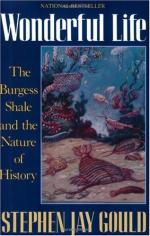
|
| Name: _________________________ | Period: ___________________ |
This test consists of 5 short answer questions, 10 short essay questions, and 1 (of 3) essay topics.
Short Answer Questions
1. When did Whittington begin studying Opabinia?
2. How did the Burgess Shale's mysteries become apparent?
3. What did Whittington attempt to do to many of the new species found in the Burgess Shale?
4. What did Gould describe as characteristic of arthropods?
5. How many years did Whittington spend on his 1979 monograph?
Short Essay Questions
1. Why did Gould write this book as an homage to the Burgess Shale?
2. How is the Precambrian Era defined?
3. Why do paleontologists find Opabinia unbelievable and fascinating?
4. Name four levels of the taxonomy of life.
5. What did people think Opabinia was and what did Whittington choose to believe about this idea?
6. What did Whittington find Opabinia to actually be?
7. How is the Marrella splendens described in relation to the other Burgess Shale fossils?
8. Why could the acceptance of the new interpretation create within humans a psychological shock?
9. What is the first chapter of "Wonderful Life: The Burgess Shale and the Nature of History" about?
10. How did Whittington try to uncover the bodily appendages of Opabinia?
Essay Topics
Write an essay for ONE of the following topics:
Essay Topic 1
Since a team controls research data, it's important that each member function in unison. Answer the following question: Is the diversity of Whittington's team a strength or a weakness? Discuss three ways in which their diversity is a strength or a weakness. Use material from the entire book to support your examples.
Essay Topic 2
In Act 1, Whittington begins to observe Yohoia. Answer the following question: Should Whittington's observations of Marrella have affected his approach to Yohoia? Use one of your own supporting ideas to back up your statement, and at least two examples from the book.
Essay Topic 3
Gould disagrees with Whittington regarding the significance of Aysehaia. Explain this disagreement in your own words. Use two examples from the book to illustrate the significance of Aysehaia, Whittington's position, and Gould's dissent.
|
This section contains 581 words (approx. 2 pages at 300 words per page) |

|




